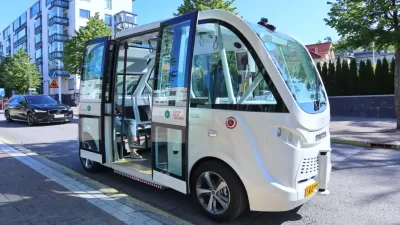Two major automakers have petitioned for the right to test thousands of vehicles without major safety features such as brake pedals and steering wheels.

Petitions from Ford and General Motors to exempt some vehicles with Automated Driving Systems (ADS) from human-operated safety controls are facing criticism from the National Association of City Transportation Officials (NACTO), which claims that the automakers are trying to avoid regulations that help ensure road safety. In an article for Streetsblog, Eve Kessler describes the complaints lodged by NACTO in a letter to the National Highway Traffic Safety Administration (NHTSA).
Automakers for years have tried to get more AVs on American streets even as evidence mounts that the machines aren’t as smart as the companies think they are and pose a danger to pedestrians and other vulnerable road users.
The companies want to introduce 2,500 vehicles annually that would be used for delivery and ride sharing services and forgo steering wheels, brake pedals, and mirrors—“that is, the controls that lets humans take over if the high-tech machinery goes haywire.” According to NACTO’s letter to federal regulators, “The companies ‘must not only establish that the controls, telltales, and devices aren’t needed for vehicles controlled by an ADS, but also prove that the ADS can successfully respond in a manner at least as safe as a nonexempt vehicle with a human driver would.’”
NACTO is also calling on the NHTSA to develop standards specific to autonomous vehicles “in ways that won’t lead to more road deaths and the destruction of cities,” which NACTO has laid out in their Blueprint for Autonomous Urbanism.
FULL STORY: NACTO Pushes Back as Big Auto Seeks Safety Exemption for Driverless Cars

Alabama: Trump Terminates Settlements for Black Communities Harmed By Raw Sewage
Trump deemed the landmark civil rights agreement “illegal DEI and environmental justice policy.”

Planetizen Federal Action Tracker
A weekly monitor of how Trump’s orders and actions are impacting planners and planning in America.

How Atlanta Built 7,000 Housing Units in 3 Years
The city’s comprehensive, neighborhood-focused housing strategy focuses on identifying properties and land that can be repurposed for housing and encouraging development in underserved neighborhoods.

In Both Crashes and Crime, Public Transportation is Far Safer than Driving
Contrary to popular assumptions, public transportation has far lower crash and crime rates than automobile travel. For safer communities, improve and encourage transit travel.

Report: Zoning Reforms Should Complement Nashville’s Ambitious Transit Plan
Without reform, restrictive zoning codes will limit the impact of the city’s planned transit expansion and could exclude some of the residents who depend on transit the most.

Judge Orders Release of Frozen IRA, IIJA Funding
The decision is a victory for environmental groups who charged that freezing funds for critical infrastructure and disaster response programs caused “real and irreparable harm” to communities.
Urban Design for Planners 1: Software Tools
This six-course series explores essential urban design concepts using open source software and equips planners with the tools they need to participate fully in the urban design process.
Planning for Universal Design
Learn the tools for implementing Universal Design in planning regulations.
Jessamine County Fiscal Court
Caltrans
Institute for Housing and Urban Development Studies (IHS)
City of Grandview
Harvard GSD Executive Education
Toledo-Lucas County Plan Commissions
Salt Lake City
NYU Wagner Graduate School of Public Service





























